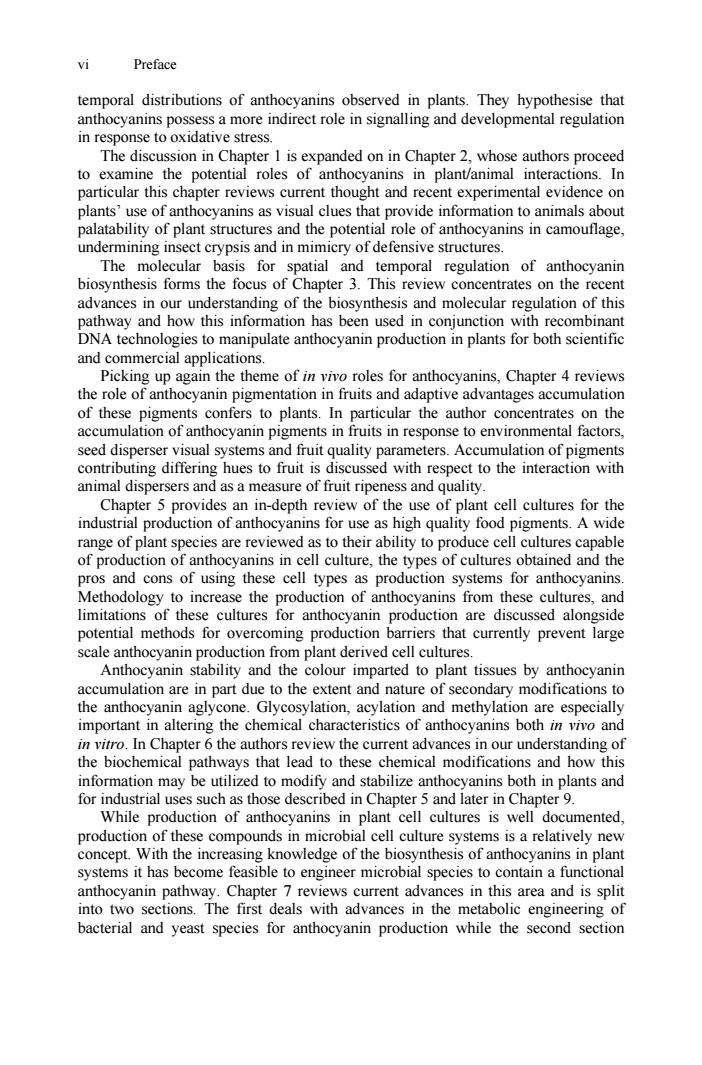正在加载图片...

vi Preface temporal distributions of anthocyanins observed in plants.They hypothesise tha anthocyanins pos s a more indirect role in signalling and developmental regulation in response to oxidative stress The discussion in Chapter I is expanded on in Chapter 2,whose authors proceed to examine the potential roles of anthocyanins in plant/animal interactions.In particular this chapter reviews current thought and recent experimental evidence on plants use of anthocyanins as visual clues that provide information to animals about palatability of plant structures and the potential role of anthocyanins in camouflage, undermining insect crypsis and in mimicry of defensive structures. The molecular basis for spatial and temporal regulation of anthocyanin biosynthesis forms the focus of Chapter 3.This review concentrates on the recent advances in our understanding of the biosynthesis and molecular regulation of this pathway and how this information has been used in conjunction with recombinant DNA technologies to manipulate anthocvanin production in plants for both scientific and commercial applications. Picking up again the theme of in vivo roles for anthocyanins,Chapter 4 reviews the role of anthocyanin pigmentation in fruits and adaptive advantages accumulation of these pigments confers to plants.In particular the author concentrates on the accumulation of anthocyanin pigments in fruits in response to environmental factors, seed disperser visual systems and fruit quality parameters.Accumulation of pigments contributing differing hues to fruit is discussed with respect to the interaction with animal dispersers and as a measure of fruit ripeness and quality Chapter 5 provides an in-depth review of the use of plant cell cultures for the range of plant species are reviewed as to their ability to cultures capable of production of anthocvanins in cell culture.the typ s obtained and the pros and cons of using these cell types as produd ion systems for anthocvanins Methodology to inc rease the production anthocvanins from these and limitations of these cultures for antho anin production are discussed potential methods for overcoming production barriers that currently prevent large scale anthoc oduction from m plant der ived cell cult Anthoc stability and the mp cd to tissues by are due to y mo ficatio ethyla espe che th the ter pter emic that d ew an n m nts and While des p of yan ture a relat With the inc ge of t nthes feasible to engineer of anth systems it has r mi ontain a anthocyanin pathway.Chapter rev ws current adva ces in this area and is spl into two sections.The first deals with advances in the metabolic engineering of bacterial and yeast species for anthocyanin production while the second sectionvi Preface temporal distributions of anthocyanins observed in plants. They hypothesise that anthocyanins possess a more indirect role in signalling and developmental regulation in response to oxidative stress. The discussion in Chapter 1 is expanded on in Chapter 2, whose authors proceed to examine the potential roles of anthocyanins in plant/animal interactions. In particular this chapter reviews current thought and recent experimental evidence on plants’ use of anthocyanins as visual clues that provide information to animals about palatability of plant structures and the potential role of anthocyanins in camouflage, undermining insect crypsis and in mimicry of defensive structures. The molecular basis for spatial and temporal regulation of anthocyanin biosynthesis forms the focus of Chapter 3. This review concentrates on the recent advances in our understanding of the biosynthesis and molecular regulation of this pathway and how this information has been used in conjunction with recombinant DNA technologies to manipulate anthocyanin production in plants for both scientific and commercial applications. Picking up again the theme of in vivo roles for anthocyanins, Chapter 4 reviews the role of anthocyanin pigmentation in fruits and adaptive advantages accumulation of these pigments confers to plants. In particular the author concentrates on the accumulation of anthocyanin pigments in fruits in response to environmental factors, seed disperser visual systems and fruit quality parameters. Accumulation of pigments contributing differing hues to fruit is discussed with respect to the interaction with animal dispersers and as a measure of fruit ripeness and quality. Chapter 5 provides an in-depth review of the use of plant cell cultures for the industrial production of anthocyanins for use as high quality food pigments. A wide range of plant species are reviewed as to their ability to produce cell cultures capable of production of anthocyanins in cell culture, the types of cultures obtained and the pros and cons of using these cell types as production systems for anthocyanins. Methodology to increase the production of anthocyanins from these cultures, and limitations of these cultures for anthocyanin production are discussed alongside potential methods for overcoming production barriers that currently prevent large scale anthocyanin production from plant derived cell cultures. Anthocyanin stability and the colour imparted to plant tissues by anthocyanin accumulation are in part due to the extent and nature of secondary modifications to the anthocyanin aglycone. Glycosylation, acylation and methylation are especially important in altering the chemical characteristics of anthocyanins both in vivo and in vitro. In Chapter 6 the authors review the current advances in our understanding of the biochemical pathways that lead to these chemical modifications and how this information may be utilized to modify and stabilize anthocyanins both in plants and for industrial uses such as those described in Chapter 5 and later in Chapter 9. While production of anthocyanins in plant cell cultures is well documented, production of these compounds in microbial cell culture systems is a relatively new concept. With the increasing knowledge of the biosynthesis of anthocyanins in plant systems it has become feasible to engineer microbial species to contain a functional anthocyanin pathway. Chapter 7 reviews current advances in this area and is split into two sections. The first deals with advances in the metabolic engineering of bacterial and yeast species for anthocyanin production while the second section